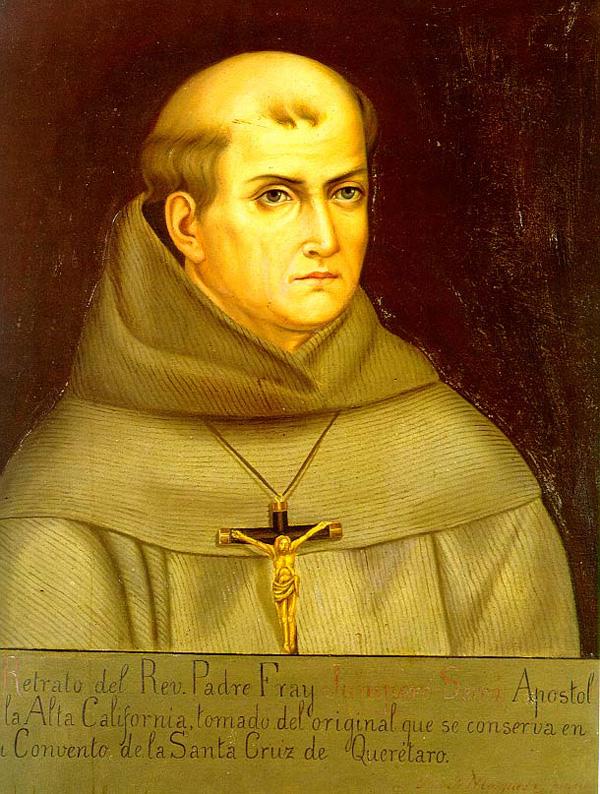Serra-gate: The Fabrication of a Saint

There is a scurrilous fabrication being disseminated by the Catholic Church regarding Junípero Serra, the missionary whom Pope Francis intends to canonize on September 23, 2015. Monsignor Francis J. Weber—whose article appears on several Catholic websites—calls Serra a “defender of the Indians’ human rights in 1773 when he journeyed from California to Mexico City to personally present to the viceroy a Representación …which is sometimes termed a ‘Bill of Rights’ for Indians.”
Note that the phrase—“sometimes termed”—implies that Serra did indeed create a “Bill of Rights” for Indians. By using the passive voice, Weber deftly avoids the issue of the claim’s accuracy. He implies what unnamed others have implied, a curious position for an archivist emeritus and author of several publications about the California missions.
Archbishop José H. Gomez makes a more audacious claim: The “Representación” “is probably the first ‘bill of rights’ published in North America,” he wrote in Angelus: The Tidings Online last January. The lower-case “bill of rights” does not indicate that there is a document labeled that way but similarly implies that there is one that can be described in those terms.
The National Catholic Review went further when it reported on May 2 that Archbishop Gomez “offered strong evidence that Serra had in fact been ‘a protector and defender of the Indians,’ and had gained a ‘Bill of Rights’ for them [from the Spanish Viceroy in Mexico City] in 1773.” The words “in fact” now assert that the Viceroy issued a document that was identified as a “Bill of Rights.”
American Catholic.org makes an even wilder claim when it states that the “outcome” of Serra’s trip to Mexico City in 1773 was “the famous ‘Regulation’ protecting the Indians and the missions. It was the basis for the first significant legislation in California, a “Bill of Rights” for Native Americans.”
These specious claims are not supported by the historical record. Let’s look at what the documents state regarding why Serra went to see the Viceroy in 1773 and what the missionary actually submitted.
Serra’s last letter before leaving San Diego was written on October 13, 1772. It was addressed to the commanding officer of the presidio at Monterey, Pedro Fages. Serra had had a difficult relationship with the officer ever since Fages had been appointed to his post two years earlier. The backstory of that letter is critical to understanding what Serra wrote and why.
In 1770, Fages replaced Gaspar de Portolá, the military commander whom Serra had accompanied in 1769 on the expedition to Alta California. In 1768, Jesuit missionaries were expelled from Baja California for having enriched themselves at the expense of the Spanish Crown. As a result, the Dominican and Franciscan replacements were accorded limited religious authority so that they could not do the same. Serra began his tenure as Padre Presidente with circumscribed powers and none over military commanders. This quickly proved a source of friction between Fages and Serra, both of whom established their headquarters in Monterey, the officer at the Presidio and Serra at Mission San Carlos Boromeo de Carmelo.
The two men had divergent views regarding establishing new missions versus civil pueblos, how the soldiers should be deployed, and what the soldiers did when off duty. Despite these differences, the two leaders established three additional missions from 1771–72. Fages refused to provide supplies and soldiers for a fourth in 1772 that had been approved at San Buenaventura. Unbeknownst to Serra, Fages had an ace in the hole.
Almost a year earlier, in November 1771, the newly appointed Viceroy, Antonio Maria de Bucareli y Ursúa, had written a letter to Fages, instructing him to direct Serra and his missionaries to “obey and comply” with Fages’s orders. Bucareli wrote the letter in response to Fages’s accounts of an earlier incident that involved the desertion of soldiers and a mule driver from the San Diego mission. Fages did not mention the helpful role that Serra and Father Paterna (from San Diego) had played in bringing about the return of the deserters. Fages only apprised Serra of Bucareli’s instructions in a letter dated October 11, 1772.
Read more at http://indiancountrytodaymedianetwork.com/2015/09/16/serra-gate-fabrication-saint-161759